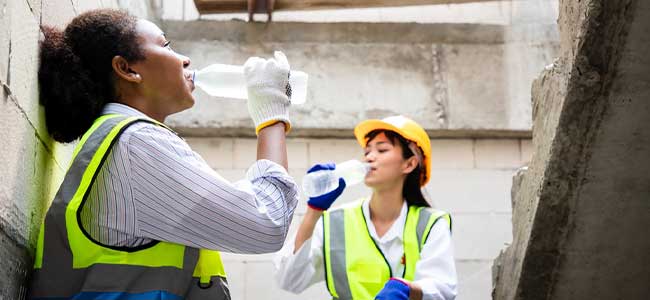
Hydrating in the Heat Part 1: How Much Water Should Employees Drink?
Knowing the amount of water to consume in hot temperatures is vital, but employees should understand when to drink water too.
- By Alex Saurman
- May 05, 2023
With summer and warm temperatures just around the corner, many employees will soon find themselves working in the heat. When the sun comes out, everyone needs to take extra precautions to ensure heat-related injuries, illnesses and fatalities are avoided.
One component of staying safe in the heat is something many people do daily and might not think about: staying hydrated.
The importance of hydration cannot be overstated. Per the University of Nebraska-Lincoln, high temperatures and physical exertion can lead to a greater chance of dehydration. Why is this a concern? Besides the fact that water keeps our bodies functioning and helps us maintain a healthy body temperature, dehydration can lead to heat injury and illness, seizures, weakness, organ damage and, in severe cases, death.
How to Stay Hydrated
Hydration shouldn’t start the moment you clock in—it should begin well before. According to the National Institute for Occupational Safety and Health (NIOSH), not only do workers want to ensure that they’re hydrated prior to starting work, but they also need to drink water before the feeling of thirst sets in. When this happens, the body may already be dehydrated.
The amount of water people should drink on a daily basis differs for everyone. Activity level, health concerns, medication and temperature all play a role in how much a person should consume. However, when it comes to staying hydrated while working in the heat, the answer is a little clearer.
Every 15 to 20 minutes, employees in hot temperatures should drink eight ounces of water, according to NIOSH. Waiting longer between drinking—even if higher quantities are consumed—is not recommended as “drinking at shorter intervals is more effective,” per the agency.
Although water is vital, drinking too much can have negative consequences. When working in high temperatures, NIOSH and OSHA say employees should avoid consuming more than 48 ounces every hour or 48 cups in 24 hours.
When work is done for the day, don’t clock out on staying hydrated. During a shift, especially in extreme temperatures, employees can sweat, causing water and salts, or electrolytes, to leave the body. These need to be replenished.
Read part two here, and stay tuned for part three of “Hydrating in the Heat.”
About the Author
Alex Saurman is a former Content Editor for Occupational Health & Safety,who has since joined OH&S’s client services team. She continues to work closely with OH&S’s editorial team and contributes to the magazine.